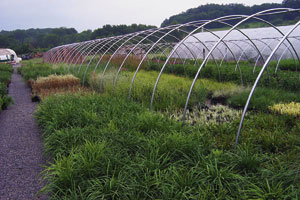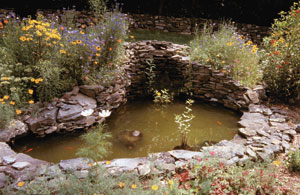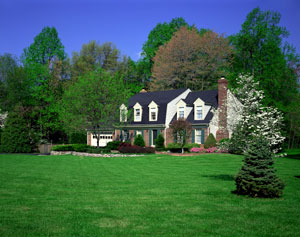Spring visions of vibrant flower beds, emerald-green lawns, and exotic garden designs run rampant, like weeds, as we await the April thaw. Garden centers begin to open, stocked with tools of the trade, hardy early annuals, and the newest chemical formulas that guarantee your garden will grow. But those insecticides, herbicides, and fertilizers may do more harm than good. If toxic chemicals don't fit your vision of "green thumbness," look to the following alternatives for making your lawn and garden come alive!
It is the perennials, shrubs, and trees in a landscape that create a lasting garden ecosystem, returning season after season, delighting the senses with colorful flowers, heady aromas, and gorgeous foliage. Gardeners routinely look for healthy root systems, unmarred foliage, and abundant flower buds when choosing plants for their permanent landscape. There is another component, however, that may ultimately mean the difference between a plant that thrives and one that withers and dies.
That component has been neatly packaged, by the New Jersey Department of Agriculture (NJDA), into the brand Jersey Grown. Similar to the popular Jersey Fresh label for produce, the nomenclature applies to qualifying Garden State growers of perennials, shrubs, and trees. "Plants propagated and/or grown in New Jersey for six months prior to retail sale" are eligible to carry the label, according to Ron Good, of the NJDA. The required "residency" ensures that the plants purchased by consumers will have adapted to local growing conditions and therefore be less likely to succumb to stressors once transplanted. Annuals, which grow and die off in one season are, by definition, not eligible for certification.
The Jersey Grown label promotes local growers to encourage local retail establishments to use these growers to supply their garden centers, and to enhance consumer awareness of the benefits of buying New Jersey grown landscape plants. Plants grown under the label are inspected and certified to be disease and pest free and must meet the stringent requirements of the American Landscape and Nursery Association. Growers that apply and pay a minimal fee for inclusion in the program receive promotional materials, such as signs, tree ties, and logos that indicate their participation. If a retail outlet sells plants grown by a qualified wholesaler, the retailer can also advertise the plants as being Jersey Grown. But even Jersey Grown plants can't thrive if the retailer does not properly care for the plants, cautions Good.
It remains difficult for NJ growers to compete in the retail garden centers with growers from warmer climates who can get a head start on the season's growth and offer more early season eye-appeal for consumers. Low shipping costs mean that these long-distance plants can actually be cheaper than locally-grown plants, where the expense of maintaining the plants through the winter and high New Jersey overhead adds up. But these imports can have a difficult time adjusting to local growing conditions. They need more maintenance, more soil inputs to maintain growth, and more protection from local pests and diseases.
Purchasing Jersey Grown plants isn't only better for your garden, it is also a means of protecting open space by supporting a viable agricultural economy in this rapidly-growing area of NJ. If you support the farmer here, you are supporting land preservation.

Another measure that will educate homeowners about the origins of their planting material is a new federal standard that requires all plants to be labeled with the grower's name and location, as well as the container size, by volume. The tags, however, are by no means prominently displayed, and it's up to the customer to read the labels. The visibility and brand identification of the Jersey Grown label will be an easy way of identifying locally-grown plants.
By selecting native plants that are well adapted to the conditions present in your garden bed, you will save a lot of chemical input, time, and maintenance.
Many plants originally introduced to gardens, boasting large flowers, fruits, or other desirable characteristics, are now considered invasive, proliferating in the wild at the expense of indigenous species. Multiflora roses, Japanese honeysuckle, Japanese barberry, and Norway maples have already disrupted natural succession and wildlife habitats. Common ornamental plants like periwinkle, some mints, crown vetch, and the butterfly bush continue to cause damage outside of the garden. Homeowners choosing to plant these should remove flowers before they go to seed, plant in containers, or aggressively pull up plants which abscond from garden boundaries.
As an alternative, there are numerous native flowers, trees and shrubs that gardeners can plant for ornamental use. Some of these may have the "showiness" of their non-native cousins, but the advantages of putting the natural plant back into the habitat can far outweigh some loss of flower power. Growing native species also helps to keep these plants established in areas where they are threatened by the spread of suburban lawns and can even help restore them to wooded or wetlands areas.
So what, exactly, would a native plant landscape entail? A native planting tends to look, well, more natural and less formalized than traditional landscaping. Larger grouping of plants, emphasizing different textures, foliage, and other elements such as seed pods, are utilized to offset the shorter bloom times and less showiness of some native species.

Appreciation of the subtleties of each plant is a mainstay of native landscaping. For example, witch hazel is fantastic in the garden during the bland days of winter. But the rest of the year it looks non-descript. So witch hazel can be a winter focal point, and during the rest of the year, it provides background structure to the other plants in the grouping, which add flowers, seed pods, and interesting foliage that combine to give the garden a intriguing, detailed and subtle effect rather than a showy frenzy of colors.
Some people choose to go native in order to attract wildlife, such as hummingbirds, songbirds and butterflies. And, by planting what naturally grows in the area, use of pesticides and herbicides is reduced.
All of the elements in an ecosystem work together to maintain healthy soil, with essential nutrients for both flora and fauna. The same occurs with your lawn. The key to a green, healthy lawn is a vibrant, living soil ecosystem. With a little care and understanding of this delicate natural balance, there is little need for pesticides, herbicides, and chemical fertilizers.
"When you just put down pesticides...you're killing all the good insects. There is no biodiversity. The only way to sustain a dead lawn is to use petroleum-based chemicals, which have a long half-life," says Anthony Vitale, owner of Organic Landscape and Design Company in Madison. Repeated dosages increases the amount of chemicals in the soil, which take a long time to break down. The chemicals can be absorbed through the skin, and can become concentrated indoors after being tracked in on shoes, pets, and clothing, Vitale explains.
Harmen J. Vos, President of The Organic Dutchman lawncare services concurs. "These chemicals are extremely dangerous to our environment, our children, pets, and just everything that lives. Chemicals kill everything and take the natural resistance out of the soil, creating a vicious circle of death and disease and actually inviting all kinds of problems to the lawn. Many residents in Northwestern NJ have private wells. Chemicals and pesticides used on lawns can easily leach into the groundwater."

The first step in natural lawn care is soil testing, which will diagnose deficiencies in any necessary elements, such as nitrogen. The ph of the soil is also a key to its health. Grass thrives with a ph of about 6.5, at which it can most optimally and efficiently absorb and utilize nitrogen. Many common weeds cannot thrive in this ph range, so weed problems are reduced. Nitrogen should only be applied after testing, and then only to the degree indicated by the test results. Excess nitrogen can leach into the ground water causing a "chain reaction" of algae blooms, disease, and damage.
Healthy roots are needed for a healthy crop of grass. Root development is naturally encouraged through deep, soaking watering every 7-10 days. Grass is cut a bit higher than usual, preventing water loss due to evaporation, and allowing the grass to better resist any weed growth. Compost is added to naturally fertilize the soil, sometimes enhanced by kelp or fish emulsions. If specific pest or weed control is required, there are organic alternatives that work naturally with the plant and soil biology.
A lawn can become dependent on chemical products. The application of chemical nitrogen supplies a "fast injection," producing green blade growth without concurrent root development. Because the underdeveloped roots can't properly store and use the needed nutrients, weeds can gain a foothold and diseases can spread. Pesticides and other chemicals disrupt the natural beneficial microbial life that normally aerate the soils. Pests can take advantage of the weakened grass, and excess nitrogen enters the watershed. The only way to keep up the appearance of a green lawn under these conditions is to give another shot of chemical life-support.
When the chemical treatments are stopped, an addicted lawn will need a period of time to be restored to a natural and healthy balance." After three or four years, you will spend less money on lawn care due to the increased health, and the fact that the lawn is living on its own," Vitale says. " For every problem in the garden, there is a natural solution. It might take, sometimes, a little more patience and work, but the results are a beautiful, strong and lush green lawn."
The long-term benefits of healthy lawn and garden care go far beyond the superficial. In fact, they go to the very core of our existence: a healthy planet. Organic lawn care is a common sense approach that results in healthy soils, healthy lawns, and a healthy environment. And selecting landscape plants which are well suited to a given environment is the first step to establishing a garden that grows naturally. By developing an ecosystem wherein the natural elements work in conjunction to promote soil fertility and plant health, the need for chemical additives no longer exists. After all, once it is understood how the natural balance, both in lawns and gardens, is easily and ultimately, effortlessly, maintained, why would anyone choose not to do so?